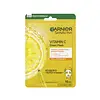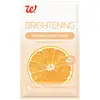What's inside
What's inside
 Key Ingredients
Key Ingredients

 Benefits
Benefits

 Concerns
Concerns

 Ingredients Side-by-side
Ingredients Side-by-side

Water
Skin ConditioningGlycerin
HumectantButylene Glycol
HumectantAmmonium Polyacryloyldimethyl Taurate
Emulsion StabilisingAscorbyl Glucoside
AntioxidantBiosaccharide Gum-1
HumectantCitric Acid
BufferingCitronellol
PerfumingCitrus Limon Fruit Extract
MaskingDisodium EDTA
Hydrogenated Lecithin
EmulsifyingHydroxyacetophenone
AntioxidantIsopropyl Lauroyl Sarcosinate
Skin ConditioningLinalool
PerfumingMannose
HumectantNiacinamide
SmoothingPhenoxyethanol
PreservativePhenylethyl Resorcinol
AntioxidantSodium Hyaluronate
HumectantXanthan Gum
EmulsifyingParfum
MaskingWater, Glycerin, Butylene Glycol, Ammonium Polyacryloyldimethyl Taurate, Ascorbyl Glucoside, Biosaccharide Gum-1, Citric Acid, Citronellol, Citrus Limon Fruit Extract, Disodium EDTA, Hydrogenated Lecithin, Hydroxyacetophenone, Isopropyl Lauroyl Sarcosinate, Linalool, Mannose, Niacinamide, Phenoxyethanol, Phenylethyl Resorcinol, Sodium Hyaluronate, Xanthan Gum, Parfum
Water
Skin ConditioningPropanediol
SolventSorbitol
HumectantTrehalose
HumectantDiglycerin
Humectant2-O-Ethyl Ascorbic Acid
Skin ConditioningHydroxyacetophenone
AntioxidantPhenoxyethanol
PreservativePolyglyceryl-6 Caprylate
EmulsifyingChlorphenesin
AntimicrobialYeast Extract
Skin ConditioningArginine
MaskingCarbomer
Emulsion StabilisingGlucose
HumectantButylene Glycol
HumectantSodium Hyaluronate
HumectantHydroxyethylcellulose
Emulsion StabilisingParfum
MaskingCitrus Reticulata Peel Extract
Skin ConditioningLeuconostoc/Radish Root Ferment Filtrate
AntimicrobialProline
Skin ConditioningWater, Propanediol, Sorbitol, Trehalose, Diglycerin, 2-O-Ethyl Ascorbic Acid, Hydroxyacetophenone, Phenoxyethanol, Polyglyceryl-6 Caprylate, Chlorphenesin, Yeast Extract, Arginine, Carbomer, Glucose, Butylene Glycol, Sodium Hyaluronate, Hydroxyethylcellulose, Parfum, Citrus Reticulata Peel Extract, Leuconostoc/Radish Root Ferment Filtrate, Proline
 Reviews
Reviews

Ingredients Explained
These ingredients are found in both products.
Ingredients higher up in an ingredient list are typically present in a larger amount.
Butylene Glycol (or BG) is used within cosmetic products for a few different reasons:
Overall, Butylene Glycol is a safe and well-rounded ingredient that works well with other ingredients.
Though this ingredient works well with most skin types, some people with sensitive skin may experience a reaction such as allergic rashes, closed comedones, or itchiness.
Learn more about Butylene GlycolHydroxyacetophenone is antioxidant with skin conditioning and soothing properties. It also boosts the efficiency of preservatives.
This ingredient is not irritating or sensitizing.
Parfum is a catch-all term for an ingredient or more that is used to give a scent to products.
Also called "fragrance", this ingredient can be a blend of hundreds of chemicals or plant oils. This means every product with "fragrance" or "parfum" in the ingredients list is a different mixture.
For instance, Habanolide is a proprietary trade name for a specific aroma chemical. When used as a fragrance ingredient in cosmetics, most aroma chemicals fall under the broad labeling category of “FRAGRANCE” or “PARFUM” according to EU and US regulations.
The term 'parfum' or 'fragrance' is not regulated in many countries. In many cases, it is up to the brand to define this term.
For instance, many brands choose to label themselves as "fragrance-free" because they are not using synthetic fragrances. However, their products may still contain ingredients such as essential oils that are considered a fragrance by INCI standards.
One example is Calendula flower extract. Calendula is an essential oil that still imparts a scent or 'fragrance'.
Depending on the blend, the ingredients in the mixture can cause allergies and sensitivities on the skin. Some ingredients that are known EU allergens include linalool and citronellol.
Parfum can also be used to mask or cover an unpleasant scent.
The bottom line is: not all fragrances/parfum/ingredients are created equally. If you are worried about fragrances, we recommend taking a closer look at an ingredient. And of course, we always recommend speaking with a professional.
Learn more about ParfumPhenoxyethanol is a preservative that has germicide, antimicrobial, and aromatic properties. Studies show that phenoxyethanol can prevent microbial growth. By itself, it has a scent that is similar to that of a rose.
It's often used in formulations along with Caprylyl Glycol to preserve the shelf life of products.
Sodium Hyaluronate is hyaluronic acid's salt form. It is commonly derived from the sodium salt of hyaluronic acid.
Like hyaluronic acid, it is great at holding water and acts as a humectant. This makes it a great skin hydrating ingredient.
Sodium Hyaluronate is naturally occurring in our bodies and is mostly found in eye fluid and joints.
These are some other common types of Hyaluronic Acid:
Learn more about Sodium HyaluronateWater. It's the most common cosmetic ingredient of all. You'll usually see it at the top of ingredient lists, meaning that it makes up the largest part of the product.
So why is it so popular? Water most often acts as a solvent - this means that it helps dissolve other ingredients into the formulation.
You'll also recognize water as that liquid we all need to stay alive. If you see this, drink a glass of water. Stay hydrated!
Learn more about Water